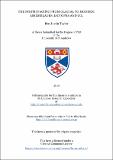Files in this item
The North Pacific from glacial to modern : assemblages, isotopes and CO₂
Item metadata
| dc.contributor.advisor | Rae, James William Buchanan | |
| dc.contributor.author | Taylor, Ben Justin | |
| dc.coverage.spatial | 209 p. | en_US |
| dc.date.accessioned | 2019-02-22T15:28:14Z | |
| dc.date.available | 2019-02-22T15:28:14Z | |
| dc.date.issued | 2019-06-26 | |
| dc.identifier.uri | https://hdl.handle.net/10023/17140 | |
| dc.description.abstract | Investigating past changes in Earth’s climate can provide useful information for assessing future climate change scenarios. Planktic foraminifera preserved in marine sediment are commonly used as a tool to reconstruct past environmental change. Here I present a combination of modern census and multinet data from the North Pacific, a new compilation of global census data, a new global calibration for Mg/Ca ratios in Neogloboquadrina pachyderma, and foraminifera assemblage, trace element, and boron isotope data from the North Pacific spanning the last deglaciation. New modern census data from the North Pacific shows that two key sub-polar proxy carrying species, N. pachyderma and Globigerina bulloides, predominantly live between 0-50 m in the water column. Global planktic foraminifera diversity is observed to be driven primarily by sea surface temperature, with upwelling and ocean productivity providing key secondary roles. In the North Pacific, a preservation bias of N. pachyderma over G. bulloides is observed when comparing multinet and core-top samples, highlighting the importance of tracking dissolution during downcore studies. To improve the use of Mg/Ca ratios in N. pachyderma downcore, I produced a new global calibration with a temperature sensitivity of 6 % per °C. This calibration was combined with boron isotope and Mg/Ca data from sediment core MD02-2489 to investigate changes in North Pacific circulation, productivity, and CO₂ during the last deglaciation. Two intervals of high surface CO₂ were observed, the first during Heinrich Stadial 1, where deep ventilation mixed CO₂ and nutrients throughout the water column. The second occurred during the Bølling-Allerød, where stratification pooled nutrients and CO₂ in surface waters, leading to enhanced productivity and CO₂ outgassing. Overall, this thesis improves the use of planktic foraminifera as tools for investigating past climate change and highlights the role of the North Pacific in deglacial CO₂ release. | en_US |
| dc.language.iso | en | en_US |
| dc.publisher | University of St Andrews | en |
| dc.rights | Attribution-NonCommercial-NoDerivatives 4.0 International | * |
| dc.rights.uri | http://creativecommons.org/licenses/by-nc-nd/4.0/ | * |
| dc.subject | Climate | en_US |
| dc.subject | Foraminifera | en_US |
| dc.subject | Deglacial | en_US |
| dc.subject | Boron | en_US |
| dc.subject.lcc | QC884.T2 | |
| dc.subject.lcsh | Paleoclimatology--Pacific Ocean | en |
| dc.subject.lcsh | Paleoceanography--Pacific Ocean | en |
| dc.subject.lcsh | Paleoceanography--Pacific Ocean | en |
| dc.subject.lcsh | Boron--Isotopes | en |
| dc.title | The North Pacific from glacial to modern : assemblages, isotopes and CO₂ | en_US |
| dc.type | Thesis | en_US |
| dc.contributor.sponsor | Natural Environment Research Council (NERC) | en_US |
| dc.type.qualificationlevel | Doctoral | en_US |
| dc.type.qualificationname | PhD Doctor of Philosophy | en_US |
| dc.publisher.institution | The University of St Andrews | en_US |
| dc.identifier.doi | https://doi.org/10.17630/10023-17140 |
The following licence files are associated with this item:
This item appears in the following Collection(s)
Except where otherwise noted within the work, this item's licence for re-use is described as Attribution-NonCommercial-NoDerivatives 4.0 International
Items in the St Andrews Research Repository are protected by copyright, with all rights reserved, unless otherwise indicated.


